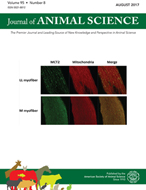-
Views
-
Cite
Cite
M. J. Estienne, A. F. Harper, Type of accommodation during gestation affects growth performance and reproductive characteristics of gilt offspring, Journal of Animal Science, Volume 88, Issue 1, January 2010, Pages 400–407, https://doi.org/10.2527/jas.2009-2081
Close - Share Icon Share
ABSTRACT
The objective was to determine effects of the type of gestation accommodation to which dams were exposed on growth performance and age at puberty in gilt offspring. Yorkshire × Landrace gilts (n = 81; 26.9 ± 0.8 kg of BW) were placed in pens of 3 gilts each. Each pen contained gilts farrowed exclusively by gilts exposed to 1 of 3 gestation accommodations: 1) individual crates throughout gestation; 2) group pens throughout gestation; or 3) crates for 30 d postmating and then group pens for the remainder of gestation (n = 9 pens/group). Performance during the 5-wk nursery period was similar among groups. The grow-finish period ended at a BW of 108.9 ± 0.8 kg, and ADG (0.98 ± 0.02 kg) was not affected (P = 0.14) by treatment. However, pig BW was affected by accommodation type × time (P = 0.04), with gilts farrowed by females housed in crates throughout gestation being heaviest during the last 4 wk. There was no effect of treatment on ADFI (2.61 ± 0.07 kg; P = 0.54); however, G:F was enhanced (P < 0.05) in gilts farrowed by females housed in crates throughout (0.385 ± 0.005) or for the first 30 d of gestation and then groups (0.382 ± 0.005) compared with gilts from females kept in groups throughout gestation (0.367 ± 0.005). Gilts from females gestated in crates throughout gestation tended (P < 0.09) to have less backfat (10.9 ± 0.5 mm) than gilts from females gestated in groups (12.5 ± 0.5 mm). After grow-finish, gilts were checked for estrus once daily. Mean age at puberty (171.9 ± 4.4 d) did not differ among groups (P = 0.61); however, fewer gilts farrowed by females gestated in crates throughout gestation (P = 0.03) reached puberty by 165 d of age (13%) compared with the other 2 groups (44%). Although specific mechanisms need to be determined, we suggest that the type of gestation accommodation in which gilts are kept may affect production performance of gilt offspring, possibly by fetal programming.





